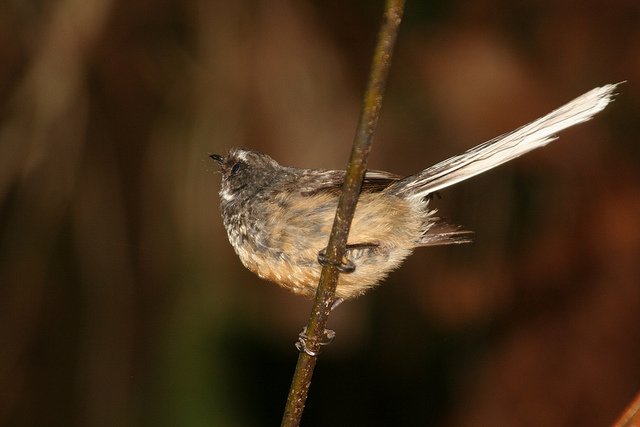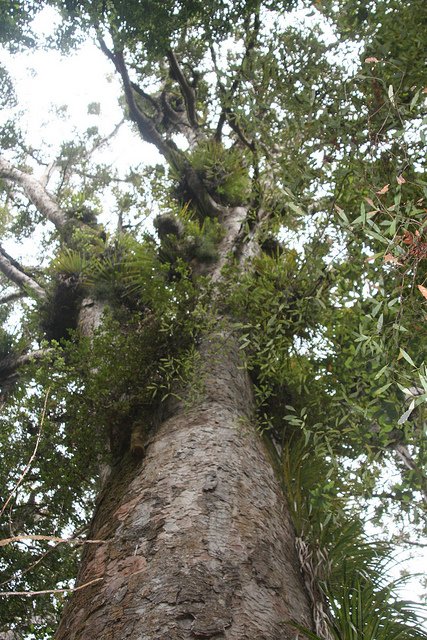Although the only pine forests found in New Zealand are recent plantations of Northern Hemisphere Pinus species like the Monterey pine, the country does have native conifers. Some of these are found throughout the country, but the most impressive species is found in the north of the island, around the Coromandel and in Northland. This is the kauri, Agathis austalis, the largest tree in New Zealand. It should actually be the New Zealand kauri, as the genus is found from Borneo to Fiji and down to New Zealand.
They are indeed mighty trees. They are comparable with the sequoias of California, reaching heights of 50 metres and girths of five metres, and since they do not taper like sequoias and thus contain more wood than a sequoia of comparable height. they are, like any large tree, slow growing and long lived, living for an estimated 2000 years. Although they may not be the most common trees in the forests they occur in, their sheer dominance means the forests are generally known as kauri forests.
 A kauri, centre, emerging from the canopy of the rest of the forest.
A kauri, centre, emerging from the canopy of the rest of the forest.
The impressive size of these trees wasn’t much protection when European settlers arrived, indeed they were actively sought out for the excellent quality (and quantity) of wood they provided. Large areas were cleared of kauri, so that around 90% of the kauri forests that once covered the North Island are gone. I recall ten years ago visiting a stand in the Coromandel that consisted of less than ten fully grown trees in a forest that once contained thousands. Fortunately there are rather larger stands of them in Northland, and on my trip up north over Christmas we visited Waipoua Forest and Trounson Forest on the west coast of Northland.
Waipoua Forest is the larger of the two forests, but we didn’t have much time to spend in it. The drive through it was rather exciting though, a winding road climbing up through dense damp and rather gorgeous forest. In the middle of the forest was a small parking area were down a short track was Tane Mahuta, the Lord of the Forest. This is the largest tree in New Zealand, 51 metres high and with a staggering girth of 13 metres.
 Tane Mahuta (well, part of it. Getting the entirely of one of these trees in frame is tricky!)
Tane Mahuta (well, part of it. Getting the entirely of one of these trees in frame is tricky!)
Trounson Forest is south of Waipoua, and had a nice walk through the Kauri. The park is popular with tourists as is the sight of a night walk that regularly sees North Island Brown Kiwi, as well as large kauri snails, a carnivorous mollusc that eats earthworms. We didn’t take the night walk (because we hadn’t booked soon enough), but the day walk was delightful too. The forest is subject to predator control to reduce pests like rats and protect the native birds (and giant worm-eating snails), and although the rarer species haven’t been reintroduced, there are still some Kokako in the park along with the Brown Kiwi. We didn’t see either, although there were plenty of Kereru (New Zealand Pigeon), North Island Robins, New Zealand Fantails and other common species.
 A New Zealand Fantail refusing to fan its tail.
A New Zealand Fantail refusing to fan its tail.
Although the kauri are now protected by law, as well as several parks created for their protection, they face a new danger. A new pathogen is spreading through the forests, kauri dieback disease. It causes lesions on the bark, dead branches, yellowing leaves and even death, and is apparently spread by disturbance of the soil, such as for example walking around the tree. In order to protect the precious kauri many forests now have biosecurity stations at the path heads, with shoe cleaning facilities. Visitors need to stick to the paths, and in many cases broadwalks are provided to avoid damaging the roots. Hopefully these massive trees will dominate the north for many thousands of years to come!












Facinating post! I had no idea that such immense trees could be found in New Zealand. Being a true treeophile (and proud of it), I hope I get the chance to see Tane Mahuta some day.
That is a mighty tree indeed. The patterning of the bark on Tane Mahuta seems unlike that of any other tree I’ve seen. But how tall is it?
Typo fixed!